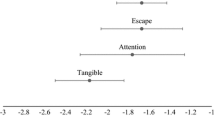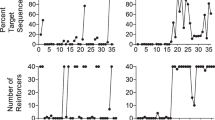Abstract
Several research laboratories have found that instructed behavior can be less sensitive to changes in contingencies than shaped behavior. The current experiment examined whether these differences in sensitivity could be related to resistance to change. Two groups of subjects, who were matched on the basis of an initial disruption assessment, were exposed to a variable-interval 30-s schedule of reinforcement with and without a disrupter. The disrupter was a video presentation of a popular television situation comedy. One group received minimal instructions (MI) that told them only that they could earn points exchangeable for money. Each member of the second group received a complete instruction (CI) that described the topography of the target response that was yoked to a MI subject’s stable baseline response rate. The response rates under the disruption condition for the CI subjects were more resistant to change than the MI subjects in 14 out of 15 disruption sessions. These findings are discussed in terms of resistance to change being increased by instructional conditions like those manipulated and that the procedures used to test disruption provide an additional method to !waluate differences between instructed and contingency-governed behavior.
Similar content being viewed by others
References
BICARD, D. F., & NEEF, N. A. (2002). Effects of strategic versus tactical instructions on adaptation to changing contingencies in children with Adhd. Journal of Applied Behavior Analysis, 35, 375–389.
DUBE, W. V., & MCILVANE, W. J. (2001). Behavioral momentum in computerpresented discriminations in individuals with severe mental retardation. Journal of the Experimental Analysis of Behavior, 75, 15–23.
FLESHLER, M., & HOFFMAN, H. S. (1962). A progression for generating variableinterval schedules. Journal of the Experimental Analysis of Behavior, 5(4), 529–530.
GALIZIO, M. (1979). Contingency-shaped and rule-governed behavior: Instructional control of human loss avoidance. Journal of the Experimental Analysis of Behavior, 31, 45–49.
JOYCE, J. H., & CHASE, P. N. (1990). Effects of response variability on the sensitivity of rule-governed behavior. Journal 01’ the Experimental Analysis of Behavior, 54, 251–262.
KAUFMAN, A., BARON, A., & KOPP, R. E. (1966). Some effects of instructions on human operant behavior. Psychonomic Monograph Supplements, 1, 243–250.
LEFRANCOIS, J. R., CHASE, P. N., & JOYCE, J. H. (1988). The effects of a variety of instructions on human fixed-interval performance. Journal of the Experimental Analysis of Behavior, 49, 383–393.
MACE, F. C., LALLI, J. S., SHEA, M. C., LALLI, E. P., WEST, B. J., ROBERTS, M., & NEVIN, J. A. (1990). The momentum of behavior in a natural setting. Journal of the Experimental Analysis of Behavior, 54, 163–172.
MCDOWELL, J. J (1988). Matching theory in natural human environments. The Behavior Analyst, 11(2), 95–109.
NEVIN, J. A., MANDELL, C., & ATAK, J. R. (1983). The analysis of behavioral momentum. Journal of the Experimental Analysis of Behavior, 39, 49–59.
SHIMOFF, E., CATANIA, A. C., & MATTHEWS, B. A. (1981). Uninstructed human responding: Sensitivity of low-rate performance to schedule contingencies. Journal of the Experimental Analysis of Behavior, 36, 207–220.
SKINNER, B. F. (1969). Contingen Cies of reinforcement: A theoretical analysis. Englewood Cliffs, NJ: Prentice-Hall.
TORGRUD, L. J., & HOLBORN, S. W. (1990). The effects of verbal performance descriptions on nonverbal operant responding. Journal of the Experimental Analysis of Behavior, 54(3), 273–291.
WULFERT, E., GREENWAY, D. E., FARKAS, P., HAYES, S. C., & DOUGHER, M. J. (1994). Correlation between self-reported rigidity and rule-governed insensitivity to operant contingencies. Journal of Applied Behavior Analysis, 27, 659–671.
Author information
Authors and Affiliations
Corresponding author
Rights and permissions
About this article
Cite this article
Podlesnik, C.A., Chase, P.N. Sensitivity and Strength: Effects Of Instructions on Resistance to Change. Psychol Rec 56, 303–320 (2006). https://doi.org/10.1007/BF03395552
Published:
Issue Date:
DOI: https://doi.org/10.1007/BF03395552




